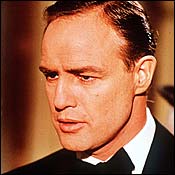
The obits of Marlon Brando, who died at 80 on July 1, emphasized his torn-T-shirt iconography and his Don Corleone; unsurprising, since Brando had the rare ability to embody, many times, a national mood. But to commemorate Brando as some kind of exalted trademark of the rebellious fifties or the ravaged seventies is to diminish his achievement, because there is so much more to these performances than sociology. Far too protean to stand as the emblem of anything, Brando ushered into the movies the present-tense immediacy of the Method, but his best performances go way beyond technique. What you get from Brando in On the Waterfront, A Streetcar Named Desire, or The Godfather, or as the furiously desolate Paul in Last Tango in Paris, is a quality of human observation and intuition equal to a great novelist’s.
In his very first movie, The Men, in which he plays a paraplegic vet, there’s a scene where he leaves the hospital to be with his bride on their wedding night, and his knee begins to shake uncontrollably as he sits in his wheelchair. His new wife, played by Teresa Wright, recoils slightly, and the look on Brando’s face, with its impasto of scorn and rage and woe, is so horrifying that he looks like a man whose life has been hauled out and murdered right in front of his eyes.
Brando could be equally eloquent in roles in which the character’s turmoil was deeply, spookily submerged. As Major Penderton in John Huston’s Reflections in a Golden Eye, adapted from a Carson McCullers novel, he played a man whose homosexuality is so repressed that it has become an incubus. As he trails the handsome soldier on whom he’s fixated (Robert Forster), the uncomprehending thrill of this brief, soft pursuit places him in a near trance. In one of the final scenes of the movie, when Brando looks into the mirror and rubs cold cream onto his waxy, immobile face in deluded expectation of his suitor’s arrival, the self-hypnosis is excruciatingly complete.
I’ve chosen examples from two lesser-known movies because too much of what was written and spoken about Brando at his death emphasized his Greatest Hits. Just because he did not have the glorious career we wanted for him should not blind us to all that he did accomplish. But why wasn’t there more? As one of Hollywood’s few geniuses, the sickening trajectory of his life has an all-too-familiar arc—Buster Keaton comes to mind, and Orson Welles, who like Brando swelled into a cartoon of himself.
And yet it would be a mistake to pin the damages of Brando’s career on Hollywood. He had the power few actors ever had to fulfill himself as an artist over a lifetime, and he threw it away. After Last Tango in Paris, when he was at his most bankable since his early years and coming off perhaps the finest performance ever put on film, he sat out the rest of the seventies and all its creative risk-taking and ferment, except for some lucrative cameos.
He chose never to appear again in a lead role. It was left to his spiritual progeny—De Niro and Pacino and the rest—to carry the torch. Why should we have been surprised at the fadeaway? After all, Brando never set foot onstage again after his triumph in Streetcar in 1947. He let it be known that acting, even at its highest level, was, in his words, “an empty and useless profession.” He despised what he did—and no one did it better.
Jeff Bridges is not often discussed as an heir to Brando, but he bears a connection in his impulsive sense of danger and in the seamless, wholly intuitive way in which he works. As Ted Cole, a womanizing children’s-book author and illustrator in The Door in the Floor, adapted by writer-director Tod Williams from the first third of John Irving’s chunky best-seller A Widow for One Year, Bridges redeems the clichéd role of spoiled artist-sot. He’s flamboyantly entertaining, which is more than this otherwise dreary movie deserves.Irving’s raucous mix of heartbreak and slapstick is a familiar playground by now—we’ve swung on these mood swings before. Ted and his wife, Marion (Kim Basinger), are on the splits since their sons were killed in a car accident. Ted works out his grief gallivanting in the Hamptons, seducing the womenfolk into posing nude for him and drawing them in squid ink. Marion is a delicately pretty zombie who nevertheless finds the energy (just barely) for her own seduction with Ted’s callow 16-year-old summertime assistant, Eddie (Jon Foster), who looks like he can’t believe his luck. The Coles’ 4-year-old, Ruth (Elle Fanning), seems much the wisest of the bunch (not such a big achievement). Williams is trying to make a movie about the different ways people cope with tragedy. Ted’s boozy, king-of-the-hill rampages are supposed to be the sport of a man who has lost all faith; Marion’s sleepwalk sorrow has brought her to a place where even her daughter can’t reach her. Fortunately, Bridges is too canny an actor to play up the carousing-through-tears bit; there is the strong suggestion in his performance—it’s the most interesting thing in the movie—that Ted has healed far better than Marion, and that this is why they are breaking up. But it would helpful if we could get any sense from Basinger of how Marion was before the accident. She’s so blotto here that it’s difficult to imagine her any other way. Her sex scenes with Eddie, which ought to be rife with tenderness and spite and rue, just sit there. No doubt we’re meant to regard them as more realistic than the standard older woman–younger man movie scenes. But since when are dullness and realism synonymous? There’s so little going on between these two that by comparison, Dustin Hoffman and Anne Bancroft in The Graduate might be performing Ibsen.